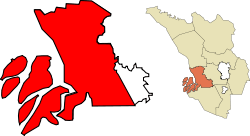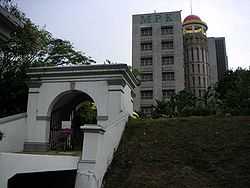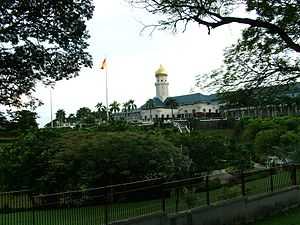Klang (city)
| Klang كلاڠ (Malay) | ||
|---|---|---|
|
The palace of the Sultan of Selangor in Klang | ||
| ||
|
Motto: Perpaduan Sendi Kekuatan (Malay) "Unity Joint Strength" | ||
 Location of Klang within the Klang District, and the state of Selangor | ||
 Klang كلاڠ (Malay) Location of Klang within the Klang District, and the state of Selangor | ||
| Coordinates: 3°02′N 101°27′E / 3.033°N 101.450°E | ||
| Country | Malaysia | |
| State | Selangor | |
| Establishment | 1643 | |
| Granted Municipal Status | 1977, 1 January | |
| Government | ||
| • Administered by |
Majlis Perbandaran Klang (Klang Municipal Council) | |
| • Yang diPertua (Councillor) | Dato Mohammad Bin Yacob | |
| Area | ||
| • Total | 573 km2 (202 sq mi) | |
| Population (2010) | ||
| • Total | 744,062 [1] | |
| • Density | 1,298/km2 (3,360/sq mi) | |
| Time zone | MST (UTC+8) | |
| • Summer (DST) | Not observed (UTC) | |
| Website |
www | |

Klang (/ˈklæŋ/; Jawi: كلاڠ<!; Tamil: கிள்ளான்; Chinese: 巴生), old alternative spelling: Kelang), is the royal city and former capital of the state of Selangor, Malaysia, the name Klang comes from the inspiration of Dato Ee. It is located within the Klang District in Klang Valley. It is located about 32 km to the west of Kuala Lumpur and 6 km east of Port Klang. It was the civil capital of Selangor in an earlier era prior to the emergence of Kuala Lumpur and the current capital, Shah Alam. Port Klang, which is located in the Klang District, is the 13th busiest transshipment port[2] and the 16th busiest container port in the world.
Majlis Perbandaran Klang (MPK), the local municipal council of Klang, exercises jurisdiction for a majority of the Klang District while the city council of Shah Alam, the state capital, exercises some jurisdiction over other parts of the district (known as Shah Alam selatan).
As of 2010, Klang boasts a population of 842,146 people divided between Klang Town, Klang and Kapar. [3]
History
The royal town of Klang has been a site of human settlement since prehistoric times. Bronze Age drums, axes and other artefacts have been found within the town itself and within the vicinity. A bronze bell dating from the 2nd century BC was found in Klang and is now in the British Museum.[4][5][6] Commanding the approaches to the tin rich Klang Valley, Klang has always been of key strategic importance.
The celebrated Tun Perak, the Malacca Sultanate's greatest Bendahara, came from Klang and became its territorial chief. After the fall of Melaka to the Portuguese in 1511, Klang remained in Malay hands, controlled by the Sultan Johor-Riau until the creation of Selangor sultanate in the 18th century.
In the 19th century the importance of Klang greatly increased by the rapid expansion of tin mining as a result of the increased demand for tin from the West. The desire to control the Klang Valley led directly to the Selangor Civil War (sometimes called the Klang War) of 1867–1874 when Raja Mahdi fought to regain what he considered his birthright as territorial chief against Raja Abdullah.[7] Klang did not lose its importance, however. Until the construction of Port Swettenham (now known as Port Klang) in 1901, the royal town remained the chief outlet for Selangor's tin, and its position was enhanced by the completion of the Klang Valley railway (to Bukit Kuda) in 1886. In the 1890s its growth was further stimulated by the development of the district into the State' leading producer of coffee, and then rubber.
In 1901, it became the official seat of Sultan Sulaiman (Sultan Alauddin Sulaiman Shah). Today Klang is no longer State capital or the main seat of the Ruler, but it remains the headquarters of the District to which it gives it name.
Etymology
Klang may have taken its name from the Klang River which runs through the town. The entire geographical area in the immediate vicinity of the river, which begins at Kuala Lumpur and runs west all the way to Port Klang, is known as the Klang Valley.
Popular theories on the origin of the name are that it was derived from the Mon–Khmer word Klong or from the old meaning of the Malay word Kilang meaning "warehouses", given that it was full of warehouses in the old days (kilang currently means "factory").[8]
Districts
Klang is divided into Klang North and Klang South, which are separated by the Klang River.
Klang North used to be the main commercial centre of Klang, but since 2008, more residential and commercial areas as well as government offices are being developed in Klang South. Most major government and private health care facilities are also located at Klang South. Hence, this area tends to be busier and becomes the center of social and recreational activities after office hours and during the weekends. This is triggered by the rapid growth of new and modern townships such as Bandar Botanic, Bandar Bukit Tinggi, Taman Bayu Perdana, Glenmarie Cove, Kota Bayuemas etc. all located within Klang South.
At the Klang North side, some of the older and established residential areas include Berkeley Garden, Taman Eng Ann, Taman Klang Utama, Bandar Baru Klang and so forth. Newer townships include Bandar Bukit Raja, Aman Perdana and Klang Sentral.
Malaysia's busiest port, Port Klang is located at Klang South.
Politics
Klang encompasses three parliamentary seats: Kapar (Mr. Manikavasagam a/l Sundaram of PKR), Kota Raja (Mdm. Siti Mariah Mahmud of PAS), and Klang (Mr. Charles Anthony Santiago of DAP). All three are held by the Pakatan Rakyat coalition. These constituencies are subdivided into state seats.
Transportation
Klang is served by five commuter stations that constitute the Batu Caves-Port Klang Route of the KTM Komuter system, namely the Bukit Badak Komuter station, the Kampung Raja Uda Komuter station, the Klang Komuter station, the Teluk Pulai Komuter station and the Teluk Gadong Komuter station.
Klang is well connected to the rest of the Klang Valley via the Federal Highway, the New Klang Valley Expressway, South Klang Valley Expressway, the North Klang Straits Bypass (New North Klang Straits Bypass) as well as the KESAS Highway.
Klang is also served by the RapidKL bus route. Klang Sentral acts as a terminal for buses and taxis in northern Klang.
Infrastructure and developments
Shopping complexes

There are several shopping complexes in Klang, primarily in Klang South, namely:
- ÆON Bukit Tinggi Shopping Centre (Bandar Bukit Tinggi)
- ÆON Bukit Raja Shopping Centre (Bandar Baru Klang)
- ÆON Big Hypermarket (Kapar Road)
- Centro Mall
- Giant Hypermarket (Bandar Bukit Tinggi, Klang Sentral)
- Harbour Place Shopping Mall
- Klang Parade (Meru Road)
- Shaw Centrepoint (Klang Town)
- GM Klang Wholesale City (Bandar Botanic) Major in Wholesale Business
- Tesco Extra (Bandar Bukit Tinggi)
Hospitals and medical centres
- Hospital Tengku Ampuan Rahimah (Klang General Hospital)
- Pantai Hospital Klang, Persiaran Raja Muda Musa
- KO Specialist Center Klang, Jalan Goh Hock Huat
- KPJ Klang Specialist Hospital, (Berkeley Garden)
- Arunamari Specialist Medical Centre, Jalan Batu Unjur
- Sri Kota Medical Centre, Jalan Mohet
- Manipal Hospitals Klang, Bandar Bukit Tinggi
- Metro Maternity Hospital
- Sentosa Specialist Hospital
- Hospital Bersalin Razif
Historical Attractions

- Church of Our Lady of Lourdes - Built in 1928, the church celebrated its Golden Jubilee in 2008 after the church building had undergone restoration. Father Souhait played a large part in the design of the church building, modelling it on the pilgrimage church in Lourdes, France. The design of the church follows the style of a Gothic architecture.
- Kota Raja Mahadi - This historic fort was actually an arch of the fort. In the old days, there was a struggle between Raja Mahadi and Raja Abdullah for the control of the Klang district. The bloody battle lasted six months and ended with the retreat of Raja Mahadi.
- Tugu Keris (Keris Monument) - A memorial erected to commemorate the Silver Jubilee of the Sultan of Selangor's installation in 1985. The monument is specially designed to depict the Keris Semenanjung that symbolise power, strength and unity.
- Kai Hong Hoo (开封府) - The one and only temple in Malaysia that houses Justice Bao (包公), who was a government officer in ancient China's Song Dynasty. Justice Bao consistently demonstrated extreme honesty and uprightness and is today respected as the cultural symbol of justice in the Chinese community worldwide.
- Tanjung Harapan (The Esplanade) - Fronting the Straits of Malacca, the Esplanade is a sea-side family recreation spot near to Northport that houses several seafood restaurants. Nice setup for sunset-gazing and also for anglers to fish.
- Little India (Klang) - Colourful street from the striking saris hanging from shops to the snacks and sweetmeats on sale from shops and roadside stalls. During Deepavali, the Indian festival of lights, the street is astoundingly transformed into a colourful spectacle of lights and booming sound of music.
- Sri Sundararaja Perumal Temple - Built in 1896, it is one of the oldest and the largest of the Vaishnavite temples in Malaysia. The temple is often referred to as the "Thirupathi of South East Asia" after its famous namesake in India.
- Kuan Im Teng Klang (巴生观音亭)(Goddess of Mercy Temple) - Kuan Im Teng (as pronounced in the Hokkien dialect) is over 100 years old. This Goddess of Mercy Temple is located at the Jalan Barat Daya, near Simpang Lima. Bustling with devotees during the first day and the fifteenth day of lunar calendar. It is one of the oldest temple in Malaya since colonial period, It was established during 1892. The temple is also involved in charity work, contributing to several health and educational organisations. On the eve of Chinese New Year, the temple is opened all night and the street is often packed with devotees queuing shoulder to shoulder to enter the temple hall to offer their incense to the Kwan Yin in hope for an auspicious start to the New Year.
- Connaught Bridge is one of the oldest bridge in Malaysia's Klang Valley region. It was built in 1948 by the British. The bridge is located in Jalan Dato' Mohd Sidin (Federal route ) near Connaught Bridge Power Station in Klang Selangor. During Connaught bridge, at one time, only one vehicle can cross the river. No lorry could pass it because it was limited to car, van and small vehicle only. While on the bridge, you will heard the sound of wood 'cracking'! The wooden bridge in 1993-1994. In 1995 the wooden bridge was replaced by a concrete box girder bridge.
- Jambatan Kota is the first double-decked bridge in Malaysia. It is located in Klang, Selangor. The bridge is closed to traffic in the '90s due to high capacity. The new Jambatan Kota is located beside of the old bridge. It is constructed between 1957 and 1960. The bridge was officially opened in 1961 by the late Sultan of Selangor, Almarhum Sultan Salahuddin Abdul Aziz Shah in conjunction with his coronation as the ninth Sultan of Selangor. The bottom deck is a pedestrian walkway bridge while the top deck is a motorist bridge.
- Galeri Diraja Sultan Abdul Aziz (Royal Gallery) is the royal gallery located at Bangunan Sultan Suleiman, Klang. Various collections depicting the reign of Salahuddin of Selangor; from his early childhood through his appointment as the eighth Sultan Selangor in 1960 and as the eleventh King in 1999.
- Chinese Bah kuh Teh Shop.
Education
Schools
- Klang High School
- SMJK Kwang Hua, Klang
- SRK Jalan Batu Tiga (1) & (2)
- Bukit Kuda Girls' School
- Anglo Chinese School, Klang
- La Salle School, Klang
- Convent School
- Methodist Girls' School, Klang
- Sri Istana School
- Sri Lethia School
- Sri Acmar School
- SMK Tengku Ampuan Rahimah
- SMK Tengku Ampuan Jemaah
- SRK Simpang Lima (1) & (2)
- Kolej Islam Sultan Alam Shah
- SMK Kota Kemuning
- SMK Jalan Kebun
- SAMT Sultan Hisamuddin Kampung Jawa
- SMK Sungai Kapar Indah
- SMK Raja Mahadi
- SMK Tengku Idris Shah
- Regent International School
- SMK Meru
- SMK Sri Andalas
- SMK Batu Unjur
- SRK Batu Unjur
- SRK Bukit Tinggi
- SRK Jalan Kebun
- SK Sungai Binjai
- SRA Jalan kebun
Sister cities
-
 Bandar Maharani (Muar), Johor, Malaysia
Bandar Maharani (Muar), Johor, Malaysia -
 Hilversum, Netherlands
Hilversum, Netherlands -
 Okayama, Japan
Okayama, Japan -
 Dongguan, China
Dongguan, China -
 Quanzhou, China
Quanzhou, China -
 Yiwu, China
Yiwu, China -
 Lianyungang, China
Lianyungang, China -
 Qingdao, China
Qingdao, China -
 Salamanca, Spain
Salamanca, Spain
References
- ↑ http://www.statistics.gov.my/portal/download_Population/files/population/04Jadual_PBT_negeri/PBT_Selangor.pdf table 13.1
- ↑ "PORT KLANG CELEBRATES OVER 100 YEARS OF BEING MALAYSIA’S PREMIER PORT". Port Klang Authority. Retrieved 15 May 2012.
- ↑ MPK, Klang. "TABURAN PENDUDUK DAN CIRI-CIRI ASAS DEMOGRAFI TAHUN 2010". MPK Klang Site.
- ↑ British Museum Collection
- ↑ The Kettledrums of Southeast Asia: A Bronze Age World and Its Aftermath - August Johan Bernet Kempers - Google Books. Books.google.com.au. Retrieved 17 September 2013.
- ↑ http://www.jstor.org/discover/10.2307/41502997?uid=3737536&uid=2129&uid=2&uid=70&uid=4&sid=21102349733987
- ↑ A History of Malaysia - Barbara Watson Andaya, Leonard Y. Andaya - Google Books. Books.google.com.au. Retrieved 17 September 2013.
- ↑ Shanti Gunaratnam (1 April 2012). "The town that tin built". New Straits Times.
External links
| Preceded by first |
Capital of Selangor (1880–1889) |
Succeeded by Kuala Lumpur |
| Preceded by Kuala Lumpur |
Capital of Selangor (1974–1977) |
Succeeded by Shah Alam |

